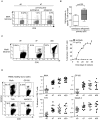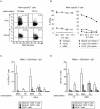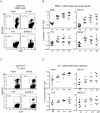A novel cancer vaccine strategy based on HLA-A*0201 matched allogeneic plasmacytoid dendritic cells
- PMID: 20454561
- PMCID: PMC2864288
- DOI: 10.1371/journal.pone.0010458
A novel cancer vaccine strategy based on HLA-A*0201 matched allogeneic plasmacytoid dendritic cells
Abstract
Background: The development of effective cancer vaccines still remains a challenge. Despite the crucial role of plasmacytoid dendritic cells (pDCs) in anti-tumor responses, their therapeutic potential has not yet been worked out. We explored the relevance of HLA-A*0201 matched allogeneic pDCs as vectors for immunotherapy.
Methods and findings: Stimulation of PBMC from HLA-A*0201(+) donors by HLA-A*0201 matched allogeneic pDCs pulsed with tumor-derived peptides triggered high levels of antigen-specific and functional cytotoxic T cell responses (up to 98% tetramer(+) CD8 T cells). The pDC vaccine demonstrated strong anti-tumor therapeutic in vivo efficacy as shown by the inhibition of tumor growth in a humanized mouse model. It also elicited highly functional tumor-specific T cells ex-vivo from PBMC and TIL of stage I-IV melanoma patients. Responses against MelA, GP100, tyrosinase and MAGE-3 antigens reached tetramer levels up to 62%, 24%, 85% and 4.3% respectively. pDC vaccine-primed T cells specifically killed patients' own autologous melanoma tumor cells. This semi-allogeneic pDC vaccine was more effective than conventional myeloid DC-based vaccines. Furthermore, the pDC vaccine design endows it with a strong potential for clinical application in cancer treatment.
Conclusions: These findings highlight HLA-A*0201 matched allogeneic pDCs as potent inducers of tumor immunity and provide a promising immunotherapeutic strategy to fight cancer.
Conflict of interest statement
Figures








Similar articles
-
Plasmacytoid Dendritic Cells and Cancer Immunotherapy.Cells. 2022 Jan 11;11(2):222. doi: 10.3390/cells11020222. Cells. 2022. PMID: 35053338 Free PMC article. Review.
-
HLA-A(*)0201(+) plasmacytoid dendritic cells provide a cell-based immunotherapy for melanoma patients.J Invest Dermatol. 2012 Oct;132(10):2395-2406. doi: 10.1038/jid.2012.152. Epub 2012 Jun 14. J Invest Dermatol. 2012. PMID: 22696054
-
[GENiusVac, a novel antitumor vaccine strategy based on allogeneic plasmacytoid dendritic cells].Rev Med Interne. 2011 May;32(5):329-32. doi: 10.1016/j.revmed.2010.07.017. Epub 2011 Mar 22. Rev Med Interne. 2011. PMID: 21429635 French.
-
Plasmacytoid dendritic cells induce efficient stimulation of antiviral immunity in the context of chronic hepatitis B virus infection.Hepatology. 2012 Nov;56(5):1706-18. doi: 10.1002/hep.25879. Epub 2012 Aug 27. Hepatology. 2012. PMID: 22707082
-
Harnessing dendritic cells for innovative therapeutic cancer vaccines.Curr Opin Oncol. 2022 Mar 1;34(2):161-168. doi: 10.1097/CCO.0000000000000815. Curr Opin Oncol. 2022. PMID: 34930882 Review.
Cited by
-
Melanoma dormancy in a mouse model is linked to GILZ/FOXO3A-dependent quiescence of disseminated stem-like cells.Sci Rep. 2016 Jul 28;6:30405. doi: 10.1038/srep30405. Sci Rep. 2016. PMID: 27465291 Free PMC article.
-
New role for antigen-presenting activated pDCs in promoting Th17 cells and impacting antitumor immunity.Oncoimmunology. 2015 May 8;4(5):e988476. doi: 10.4161/2162402X.2014.988476. eCollection 2015 May. Oncoimmunology. 2015. PMID: 26155409 Free PMC article.
-
Plasmacytoid dendritic cells and their therapeutic activity in cancer.Oncoimmunology. 2012 Aug 1;1(5):726-734. doi: 10.4161/onci.20171. Oncoimmunology. 2012. PMID: 22934264 Free PMC article.
-
Human CD34+-derived plasmacytoid dendritic cells as surrogates for primary pDCs and potential cancer immunotherapy.Front Immunol. 2024 Nov 7;15:1433119. doi: 10.3389/fimmu.2024.1433119. eCollection 2024. Front Immunol. 2024. PMID: 39575246 Free PMC article.
-
Plasmacytoid Dendritic Cells and Cancer Immunotherapy.Cells. 2022 Jan 11;11(2):222. doi: 10.3390/cells11020222. Cells. 2022. PMID: 35053338 Free PMC article. Review.
References
-
- Finn OJ. Cancer immunology. N Engl J Med. 2008;358:2704–2715. Review. - PubMed
-
- Thurner B, Haendle I, Röder C, Dieckmann D, Keikavoussi P, et al. Vaccination with mage-3A1 peptide-pulsed mature, monocyte-derived dendritic cells expands specific cytotoxic T cells and induces regression of some metastases in advanced stage IV melanoma. J Exp Med. 1999;190:1669–1678. - PMC - PubMed
-
- Palucka AK, Dhodapkar MV, Paczesny S, Ueno H, Fay J, et al. Boosting vaccinations with peptide-pulsed CD34+ progenitor-derived dendritic cells can expand long-lived melanoma peptide-specific CD8+ T cells in patients with metastatic melanoma. J Immunother. 2005;28:158–168. - PubMed
Publication types
MeSH terms
Substances
LinkOut - more resources
Full Text Sources
Other Literature Sources
Medical
Research Materials

